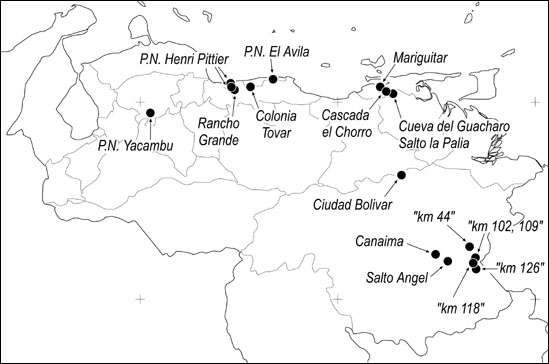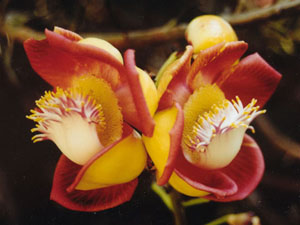 In
November and December 2002 I visited Venezuela with one main goal: to
collect
a large series of the only known spider (at that time) with asymmetric
male genitalia:
Metagonia
mariguitarensis. Of course this was not the only aim. Venezuela
contains
the type localities of many spiders that Eugène Simon described
after visiting
the country in 1887-1888. Some of his species had only been known from
the
type material, often just one or a few specimens. Visiting some of the
very same localities as Simon was thus a major goal. This brought us
for
example to the lovely but somewhat surreal Colonia Tovar. This 19th
century-style
German town, surrounded by tropical montane rainforest, is well known
to
readers of Isabel Allende. We found virtually all of Simon's pholcid
spider
species.
In
November and December 2002 I visited Venezuela with one main goal: to
collect
a large series of the only known spider (at that time) with asymmetric
male genitalia:
Metagonia
mariguitarensis. Of course this was not the only aim. Venezuela
contains
the type localities of many spiders that Eugène Simon described
after visiting
the country in 1887-1888. Some of his species had only been known from
the
type material, often just one or a few specimens. Visiting some of the
very same localities as Simon was thus a major goal. This brought us
for
example to the lovely but somewhat surreal Colonia Tovar. This 19th
century-style
German town, surrounded by tropical montane rainforest, is well known
to
readers of Isabel Allende. We found virtually all of Simon's pholcid
spider
species.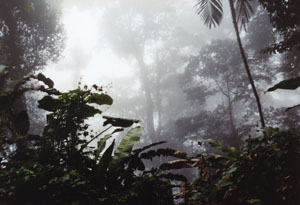 Another
few days were spent collecting at Rancho Grande and in Henri Pittier
National
Park. This is where William Beebe collected tons of data and material
in
the 1940ies, visiting the site with half a ton of equipment. Our
strategy
was to be quick and flexible and to visit as many sites as possible.
The most important
equipment: a bottle of ethanol and lots of vials.
Another
few days were spent collecting at Rancho Grande and in Henri Pittier
National
Park. This is where William Beebe collected tons of data and material
in
the 1940ies, visiting the site with half a ton of equipment. Our
strategy
was to be quick and flexible and to visit as many sites as possible.
The most important
equipment: a bottle of ethanol and lots of vials. 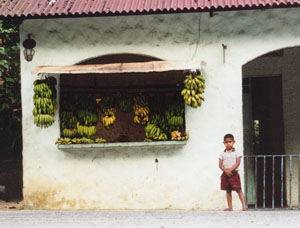 The
trip down to Sabana Grande should bring us to the type locality of Kaliana
(now Mesabolivar)
yuruani. This is among the pholcid spiders wiith the most unusual
and extravagant
male reproductive organs, but only a single male had been known,
deposited
in the American Museum in New York. These tiny spiders (about 2 mm body
length) live very cryptically in the leaf-litter but we managed to find
some males and females.
The
trip down to Sabana Grande should bring us to the type locality of Kaliana
(now Mesabolivar)
yuruani. This is among the pholcid spiders wiith the most unusual
and extravagant
male reproductive organs, but only a single male had been known,
deposited
in the American Museum in New York. These tiny spiders (about 2 mm body
length) live very cryptically in the leaf-litter but we managed to find
some males and females. 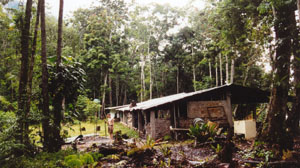 A
flight to Canaima and a boat trip from there to Salto Angel brought us
as close to the tepuis as was possible. I had always been fascinated by
this incredible geological formations and had hoped to find quite a
number
of pholcid species in the untouched rainforests at Auyan-Tepui. To my
surprise,
there was only one new species of Mesabolivar (in the meantime
described as M. macushi). Otherwise, the gorgous
forest appeared quite devoid of spiders. In comparison, we found about
40 pholcid species alltogether during our 4-weeks-trip, about 20 of
them
new to science.
A
flight to Canaima and a boat trip from there to Salto Angel brought us
as close to the tepuis as was possible. I had always been fascinated by
this incredible geological formations and had hoped to find quite a
number
of pholcid species in the untouched rainforests at Auyan-Tepui. To my
surprise,
there was only one new species of Mesabolivar (in the meantime
described as M. macushi). Otherwise, the gorgous
forest appeared quite devoid of spiders. In comparison, we found about
40 pholcid species alltogether during our 4-weeks-trip, about 20 of
them
new to science.The map below shows the localities we visited. Most of the time we were just two: Boris Striffler and me. Only in Yacambu we were a group of five, including Osvaldo Villarreal and Abel Pérez González, to both of whom I owe much for arranging the permits. This expedition was financed in part by the German Research Foundation (DFG), project HU 980/1-1.
Numerous publications have resulted from this trip or have profited from material collected at this trip (Huber 2004, Huber, Perez & Baptista 2005, Huber 2005, Astrin et al. 2006, Huber 2006, Bruvo et al. 2005, Astrin et al. 2007, Huber & Arias 2017, Huber 2018, Huber & Carvalho 2019, Huber & Villarreal 2020).
